Decorative honeysuckle - planting and care
Decorative honeysuckle (Honeysuckle) is a shrub designed to decorate a site. It has bright, large, beautiful leaves, and during flowering it is covered with many unusual large and bright inflorescences. The plant bears fruit with small bright orange berries that seem to lie on the leaves. They are not edible, but they look beautiful and aesthetically pleasing.
Honeysuckle vine is a climbing plant. They decorate fences, gazebos and building facades. With proper care, the length of the shoots reaches more than 6 m.
Read the article about planting climbing honeysuckle and caring for it in the Moscow region and other regions of the country.
Planting decorative honeysuckle in open ground
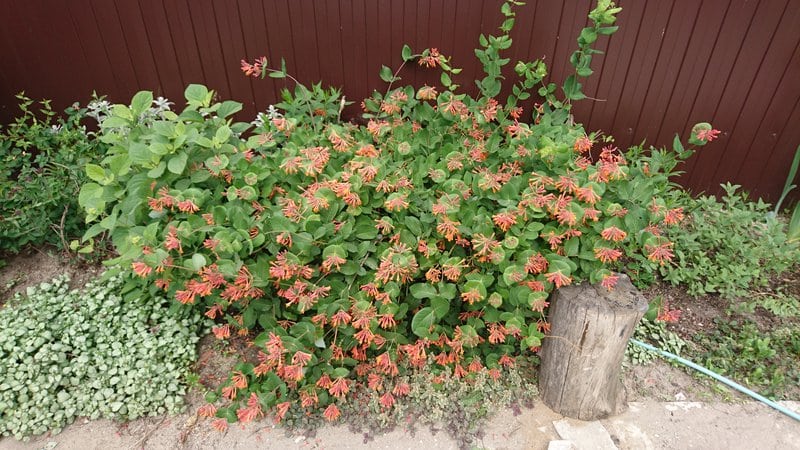
Honeysuckle honeysuckle can be propagated in 4 ways. The list provides a description of each of them:
- Cuttings. These are pruned shoots of vines that were rooted at least six months before planting. This is the most common way to grow ornamental honeysuckle.
- Layerings. The shoot is laid on the ground, and its part located near the bush is sprinkled with soil. Throughout the summer, the cuttings are watered and fed abundantly. In autumn, the shoot with roots is separated from the mother plant. This method requires a minimum of attention from the gardener.
- Division. The root system of the vine is dug up. The root is divided into several parts along with the shoots. The resulting bushes are planted separately from each other. Division is considered the fastest method of propagating honeysuckle.
- Seeds. They are collected from honeysuckle fruits or bought in a store.The seeds are sprouted at home until the plant is old enough. This propagation option takes the longest, but the plants obtained with its help will be the hardiest.
Plant the plant in spring or autumn - at these times of the year honeysuckle takes root the fastest. The landing technique is the same in both cases.
During autumn planting, work is carried out in mid-October (in the central regions, Leningrad and Moscow regions) and in mid-November (in the southern regions). Before the onset of frost, the sedimentary material will take root, but the buds will not have time to open. When it gets colder, the plant will go into a dormant state and calmly survive the winter.
In spring, planting work is carried out before the beginning of the growing season. This is done as soon as the snow melts and the temperature reaches above zero. This occurs in early May for the southern regions and in mid-April for the central regions.
Note! When planted late, honeysuckle takes root worse and begins to hurt. In late spring, only seedlings with a closed root system are allowed to be planted.
Site selection and soil preparation
Before planting decorative honeysuckle, it is important to choose a suitable place for it. The liana feels best in sunny areas of the garden. It is here that the most abundant flowering and fruiting of the plant is observed.
Important. The liana can also grow in semi-shaded areas. In this case, its flowering will be less abundant.
Place the vine near a support - building facades, fences, gazebos or trellises.
Honeysuckle can grow on any soil, except waterlogged swampy and dry sandy soils. In other cases, the plant will feel good if nutrients are added before planting and during growth.
The soil for honeysuckle is prepared 2-3 days before planting. To do this, dig a hole with a diameter of 40 cm. The soil removed from the hole is mixed with 10 kg of humus or rotted manure, 300 g of ash, 100 g of superphosphate and 30 g of potassium sulfate.
The soil mixture is immersed back into the hole, but not compacted. Some of the soil will have to be pulled out before planting.
Selection and preparation of seedlings
It is equally important to choose suitable planting material. Seedlings must meet the following parameters:
- Age. Seedlings that are 2-3 years old take root best. They should have 2-3 branches.
- Size. The optimal height is up to 40 cm. The diameter of the shoots should be at least 0.5 cm.
- Quality of shoots. They should not be dry and flexible. It is important to have 3 or more living buds on each branch. There must be no damage, stains, rot or other signs. diseases.
- Root system. It should be well developed, have large and small branches. Seedlings with a closed root system take root best (sold in a pot in a coma of earth). If planted in a timely manner, budget specimens with an open root system will also take root (sold without a planting container, the roots are cleared of soil).
Peeling of the bark occurs on some seedlings. You should not be afraid of this sign, as it is considered a cultural feature.
It is important to prepare planting material. To do this, the roots of the seedling are soaked for 1 hour for 2 hours in a dark pink solution of potassium permanganate or “Fitosporin”. Then the roots are immersed for 6-12 hours in a solution of a growth stimulator (“Kornevin”).
Step-by-step landing instructions
Planting honeysuckle in open ground is not difficult. However, it will take root only if you follow the step-by-step instructions:
- The nutrient soil mixture is removed from the hole.A layer of drainage is poured onto the bottom (broken brick, crushed ceramics, small expanded clay). A slide of earth is formed in the center of the hole.
- The seedling is placed in the hole. If the root system is open, then the roots are distributed around the earthen mound.
- The hole is filled with soil so that the root collar is 5 cm below the ground level. After settling, this part of the seedling will open.
- Immediately after planting, the soil is compacted. Honeysuckle is watered generously (5-10 l) with a light pink solution of potassium permanganate at room temperature.
If several honeysuckle seedlings are planted along fences in one row, then the distance between them should be at least 1 m. Otherwise, the honeysuckle will be in the shade and get sick.
Plant care
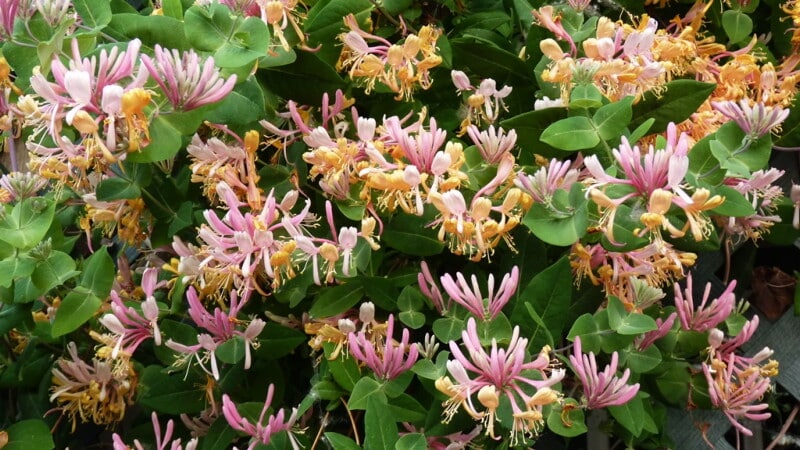
In order for the vine to bloom profusely and beautifully, produce bright fruits and not get sick, it is important to properly care for it. Basic rules growing crops are presented in the list:
- Watering. The first time honeysuckle is watered is when it takes root (2 weeks after planting). Then the plant is watered once a week. In hot and dry weather, the soil is moistened every 3 days. Up to 2 buckets of settled water at room temperature are used per plant. Water honeysuckle in the morning or evening when the sun is not active. Otherwise, burns will occur.
- Weeding and loosening. After each watering, the soil is loosened to destroy the earthen crust, which prevents full air exchange, causes stagnation of moisture and the development of root diseases. During the loosening process, weeds that spread the disease must be removed.
- Feeding. Fertilizers are applied at the root 3-4 times a year. In summer, foliar feeding is used.
- Mulching. Mulch protects honeysuckle from diseases, cold weather and pests, slows down the growth of weeds, prevents the formation of an earthen crust, slows down the evaporation of moisture, and acts as an additional fertilizer. As mulch, the soil is covered with sawdust, chopped bark, rotted hay or straw, and burlap.
- Support. Liana needs support. This can be any vertical surface located on the site, or artificially created trellises and decorative installations. As the shoots grow, they are twisted around the support counterclockwise.
Now let's look at the most important stages of care in more detail.
Feeding
Proper feeding is the key to the active growth of decorative honeysuckle. For this plant use the following scheme:
- Fertilizers are applied for the first time when the snow melts and the soil freezes. Apply 20 ammonium nitrate to each vine or water it with a urea solution (1 tbsp urea per 10 liters of water).
- The second feeding is done in early May. To prepare the fertilizer, 1 kg of chicken droppings or rotted manure is diluted in a 10 liter bucket of water. The mixture is allowed to brew for 3 days, after which it is poured under the vines.
- The third feeding occurs in June. Slurry or 30 g of nitroammophoska diluted in a 10 liter bucket of water is used as fertilizer.
- The last time fertilizer is applied is before wintering. The nutritional composition is prepared from 5 kg of compost, 1 tbsp. ash and 35 g of superphosphate.
In July, honeysuckle is sprayed with a solution of microelements.
Important! Fertilizers are applied when the sun is not active (in the morning or at sunset). Before applying fertilizers, be sure to water the plants.
Trimming
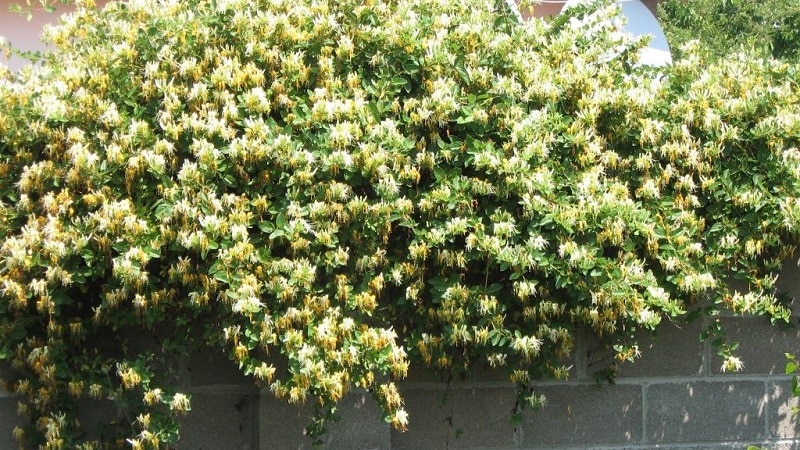
Pruning is the key to healthy and beautiful honeysuckle. This procedure gives the plant shape, stimulates vegetation and flowering.This procedure is also one of the main conditions for disease prevention. There are 4 types of pruning.
Each of them has its own nuances:
- Stimulating. I cut off the top of the main stem of the vine when it reaches the top fulcrum. It is powdered with ash. This procedure stimulates the formation of new shoots.
- Formative. When the side shoots reach the desired length, the growing points are cut off. The branches are directed towards the support. The cut site is also treated with ash. It will not be possible to give vines a fantasy shape.
- Rejuvenating. After planting, the seedling is pruned to a height of 30 cm. If the honeysuckle begins to produce few shoots and has poor flowering, it is pruned at a height of half a meter from the ground. This will stimulate the formation of young strong shoots.
- Sanitary. Remove all parts of the plant with signs of disease and insect damage, shoots with unopened buds, dry and weak branches.
Pruning is carried out in spring or autumn. This is done when the sun is not active. It is important to disinfect the pruning shears before use, and dust the cut areas with ash.
note! Healthy pruned shoots are often used as cuttings.
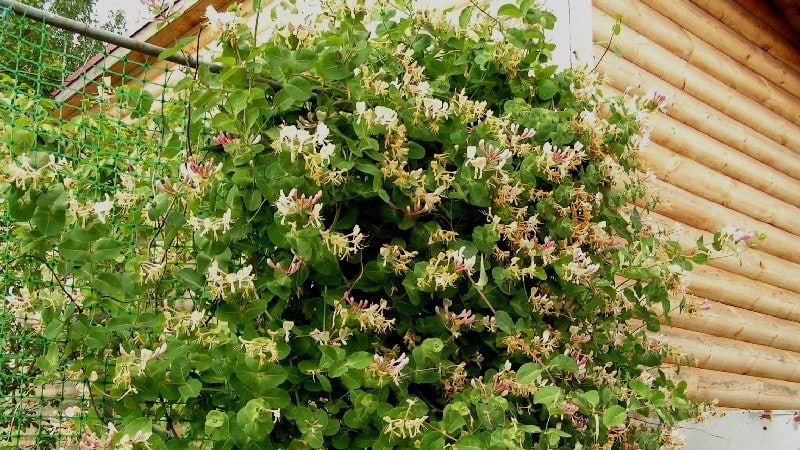
Wintering
Honeysuckle is a cold-resistant plant. It can withstand temperatures down to -40°C. However, properly preparing it for winter is also important.
One-year-old honeysuckle is completely covered with dry leaves and spruce branches. It is possible to use film. An adult plant is removed from its support and laid out on a base of leaves. It is covered with spruce branches on top. During the winter, it is recommended to shovel snow onto the vine.
In the spring, after the snow grows, the vine is opened (cleared of spruce branches). Then it is again attached to the support.
Diseases and pests
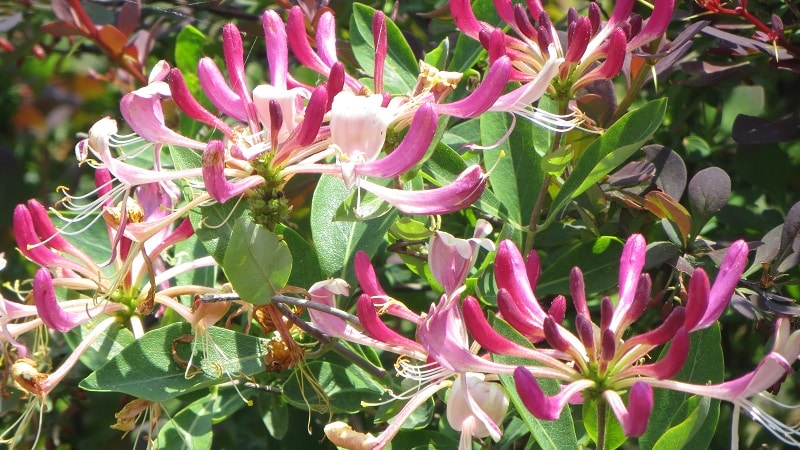
There are several common dangerous diseases that can affect honeysuckle. The three most common are:
- Tubercularosis. Lumpy red formations appear on the branches and shoots of the vine. Leaves and shoots dry out and then die.
- Rumulariasis. Symptoms of the disease are brown spots on the leaf blades in the center and grayish along the edges. The disease leads to the death of leaves and shoots.
- Cercospora blight. Leaves and shoots are covered with red-brown dots. The disease leads to impaired photosynthesis and premature leaf fall.
The causative agents of the described diseases are fungi. To cure any of the diseases, the affected parts of the plant are removed and burned. If the shoots have been removed, then the cut areas are powdered with ash or lubricated with garden pitch.
Infected plants are sprayed with preparations containing copper. Fungicides are also effective. They are used at any time of the year, since the fruits of decorative honeysuckle are inedible.
Most often, honeysuckle is attacked by a pest such as aphids. The insect feeds on plant sap, causing leaves and young shoots to dry out. To get rid of the pest, the vine is sprayed with a soap solution or a decoction of bitter herbs.
To prevent honeysuckle from getting sick, it is important to follow the rules of prevention. They are presented in the list:
- preventive spring treatment with copper sulfate;
- weed removal;
- sanitary pruning;
- treatment of planting material, garden tools and soil with disinfectants;
- compliance with watering rules;
- soil mulching;
- timely pest control;
- applying sufficient amounts of fertilizer.
Note! It is not recommended to plant honeysuckle and juniper in the same area. This proximity contributes to the infection of the vine rust.
Conclusion
Decorative honeysuckle can become the main decoration of the garden. Its large inflorescences, collected from many bright flowers, immediately attract attention. The plant looks no less interesting during the fruiting period, when small orange berries appear on the round large bright green leaves.
Growing decorative honeysuckle is a task that even a novice gardener can handle without any problems. The plant is unpretentious and easily tolerates negative environmental factors. The success of growing vines depends on proper planting, pruning, regular watering and fertilizing.